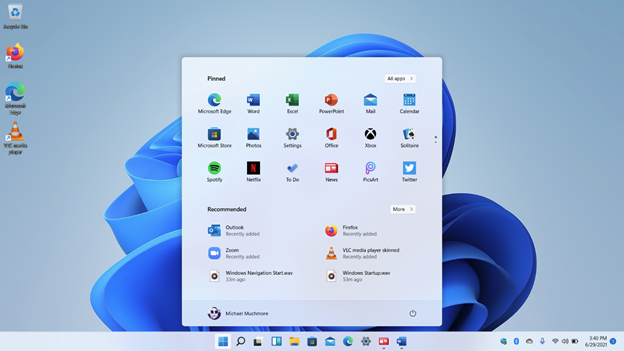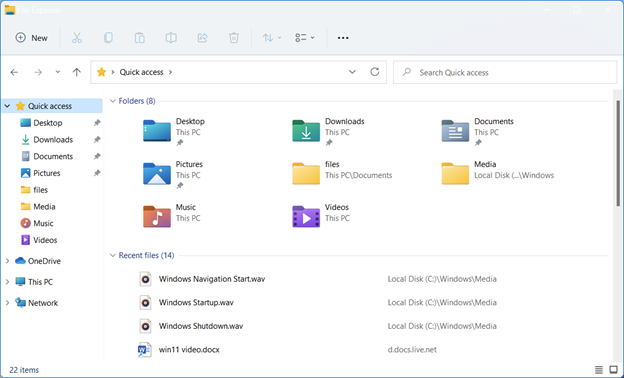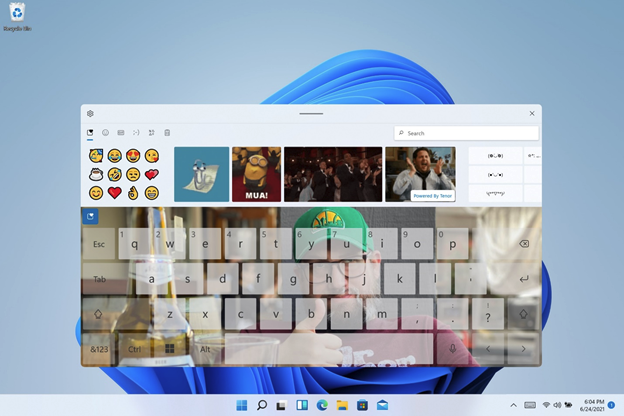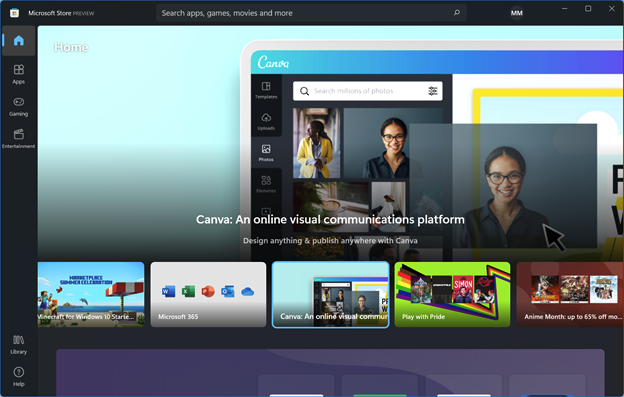
Windows 11 is the latest version of Microsoft’s operating system for computers. Released on October 5, 2021, the successor to Windows 10 comes with a cleaner, more minimalist look, including redesigned icons, translucent windows, new iconography, and a centralized Start Menu. The software also brings advances in productivity, with emphasis on the new layout snaps – a special way to manage windows –, integration with Microsoft Teams, and improved support for virtual desktops.
The new Windows also includes a revamped Microsoft Store, integrated with the Amazon store. The system, however, comes due to one of Microsoft’s great promises: native support for Android applications, to be released in future updates. With this, it will be possible to run apps from Google’s operating system without installing emulators.
Initially, all Windows 10 users can update to the new version of the operating system: just use Windows Update, accessible on the computer itself, or the Windows 11 installation wizard, available on the Microsoft website. However, the PC needs to meet minimum requirements.
DESKTOP AND VISUAL
One of the great new features of Windows 11 is the graphical interface. Microsoft sought to modernize the design of the operating system with a series of tweaks. The new system comes with redesigned icons and windows with rounded edges, highlighting the “glazed” aspect, with clear transparencies and blurring.

The result is good and works by contrast: the comparison makes Windows 10 look much older and equates Microsoft’s new product with newer design standards found in rival products such as Apple’s macOS. The only major constraint is still the limited level of customization.
START MENU AND TASKBAR
Among the most visible modifications of Windows 11 are the new Start Menu and taskbar. In Start, the user finds a more visually simple menu than the version available in Windows 10: the tool organizes recent applications and files, in addition to providing a space for user-pinned apps.

The taskbar, in turn, got a little bigger and comes, by default, with centered icons. It is possible to realign it to the left, but the ability to move the bar along the edges of the screen has been eliminated from Windows.
NEW WINDOW MANAGEMENT MODE
Window management has been reinforced with an improved virtual desktop support mode. The novelty facilitates the division and organization of screens on the desktop, being useful for those who share the PC with other people.
Another improvement concerns the Layout Snap feature: moving the cursor over the maximize button displays a menu of pre-determined layouts, where the user can define an organization pattern to make better use of the free space on the screen.
WIDGETS
Much of what used to be inside the Start Menu, such as dynamic tiles with up-to-date information for each app, ended up in the Widgets feature. The element is part of the taskbar and allows the user to set up a dynamic content feed and add the information they consider most relevant to the dashboard, such as news, weather, quotes, etc.

‘CORTANA’ HIDDEN
In Windows 10, the virtual assistant Cortana was one of Microsoft’s great approaches: the tool was integrated into the system and even came, by default, fixed to the taskbar. Since then, Cortana has ended up failing in the task of consolidating in the market as an option to the dominant Google Assistant, Alexa, and Siri, so that, in Windows 11, the app and the service even exist, but their use is optional, and the user needs to effectively search for the assistant to access it.
MICROSOFT STORE OVERHAUL AND ANDROID APP SUPPORT
The Microsoft store received a new graphical interface and has a more modern appearance, in line with the manufacturer’s other products. The changes to the Microsoft Store benefit both developers and regular users. From this version onwards, the store allows those responsible for the programs to receive the total amount of the generated revenues.

Users also received attention from Microsoft. On Windows 11, you will be able to install Android apps and run them natively. This is thanks to the integration with the Amazon Appstore, Amazon’s version of the Google Play Store, which uses Intel technology to offer the feature to people. Microsoft did not give a release date for the function, although there is a lot of curiosity about the feature. The novelty would bring Windows 11 closer to macOS, which does something similar on Macs with an M1 processor.
INTEGRATION WITH MICROSOFT TEAMS
Microsoft Teams — a unified communications platform — allows users to use chat and video conferencing to communicate and store files. The service is also integrated into Windows 11, making it possible to activate the tool’s chat and start meetings — audio and video — from the taskbar.
GAMING TECHNOLOGIES AND XBOX GAME PASS
For those who play on the computer, Microsoft brings in Windows 11 some important news. The first of these is Direct Storage technology: inspired by the internal architecture of the new Xbox, Microsoft’s solution promises to make loading games on the system much faster.
Another improvement is Auto HDR, also found on the developer’s next-gen consoles. The feature automatically applies HDR to content that was not originally developed with the technology, rendering more vivid visuals on compatible displays.
Finally, the Xbox Game Pass subscription service is also present in Windows 11. It can be configured by users to create a larger interaction network. Integration between the two platforms— Xbox and PC—provides faster and easier access to games, social media, and the Xbox store.
OUR OPINION
To some extent, Windows 11 can be considered a breakthrough for Microsoft. The developer once declared that Windows 10 would be the last Windows, a stable operating system to be expanded and evolved by free updates released over the years. Although the promise has been kept, to some extent, the arrival of Windows 11 brought a dose of a surprise to those who did not expect a new system.
If you have a compatible computer, Windows 11 is a recommended update: the system retains the same stability that marked the launch of its predecessors, especially Windows 7 and 10, but it arrives with a more pleasant graphical interface to use. Modern, Windows now has a macOS and Android feel, with smoother, rounder windows, a plethora of transparency, blur effects applied across windows, and open dialog boxes over the rest of the screen.
The impressions, so far, are positive: the graphical revisions modernize the platform without breaking what traditionally characterizes the Windows user experience. If there is any criticism of Microsoft’s approach, this is the limitation in customization: the system is very restricted in its customization possibilities.
In addition to a new face, Microsoft has introduced notable new features such as improved support for virtual desktops, a new Snaps layout, deep integration with Teams, a Widgets panel, and a more useful and cohesive Settings app. Gamers should have HDR support within old games, and new releases – on PCs with high-speed SSDs – will load faster thanks to Direct Storage technology.
But not everything about Windows 11 is positive. The requirement for the famous TPM 2.0 module to install and support the software on computers is understandable – hardware has been a relevant security component and an industry standard for some years now – but Microsoft has released the requirement reticently and sometimes, confused. There were even retractions and openings of contours so that incompatible computers could run the new Windows. All this creates a scenario where many users still do not have a clear idea about the compatibility of their PCs with Windows 11.
Another criticism is that the functionality of native support for Android apps right on the PC ended up being delayed, deflating some of the enthusiasm about the launch. The feature announced among the first novelties for the system, still does not have a date to reach users.
Also worth mentioning is the tracking between Windows 11 Home and Pro: the Pro version comes with very useful security features, such as Sandbox, which are inaccessible to users of the Home package. In comparison, rival Apple strictly delivers the same macOS, whether you have a beefier or a simpler MacBook.
Overall, our experience with Windows 11 was positive. The system is stable, the contrast of the new graphical interface with the previous experience in Windows 10 emphasizes how much the 2015 product has aged, and, for those who have a compatible computer, it is difficult to find arguments that contraindicate the upgrade. The upgrade will be free if you have a valid Windows 10 license active, and there is no loss of features or functionality when performing the migration.
PROS
The graphical interface is more modern and pleasant to use
New productivity features make the difference
The system is very stable and does not compromise the workflow of those leaving Windows 10
CONS
Native support for Android apps has no date to arrive
Confusing communication about support and compatibility on older computers
Windows 11 Pro features would be very welcome in Home
 iTechBahrain Information Technology Digital Marketing Web & Mobile Development Services
iTechBahrain Information Technology Digital Marketing Web & Mobile Development Services